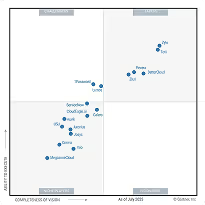HIPAA Compliance Checklist for 2025

The average enterprise now manages over 300 SaaS apps, compared to just 16 a decade ago. As SaaS adoption explodes, IT leaders face growing challenges, from SaaS sprawl and duplicate tools to hidden costs and compliance risks.
According to Gartner, companies overspend by 25 to 35% on SaaS each year due to poor visibility and manual management. That’s why having a clear SaaS maturity model is critical for every modern enterprise.
Most enterprises fall into one of four SaaS maturity levels: Ad-Hoc, Reactive, Proactive, or Strategic. Progressing through these stages isn’t just about adding tools; it’s about transforming SaaS management into a strategic advantage that drives savings, security, and productivity.
The shift has already begun; companies are adopting SaaS management frameworks to automate tasks, cut costs, and improve compliance. Let’s look at each stage of the SaaS maturity model and see how to reach a fully smart, data-driven SaaS management state.
TL;DR
- The SaaS maturity model shows how well a company manages its SaaS tools and spending.
- There are four SaaS maturity levels — Ad-Hoc, Reactive, Proactive, and Strategic.
- Moving up the levels helps teams improve visibility, control, and automation.
- A mature SaaS management setup saves time, reduces costs, and strengthens security.
- CloudEagle.ai helps businesses reach higher maturity by automating SaaS tracking, renewals, and governance.
What is SaaS Management Maturity?
SaaS management maturity measures how well an enterprise manages its SaaS ecosystem, from app discovery and spend visibility to governance, compliance, and optimization. It shows how effectively a company tracks, controls, and gets value from its software subscriptions.
As enterprises grow, SaaS usage often expands faster than IT can control it. Teams purchase tools independently, leading to shadow IT, duplicate apps, and unused licenses.
A well-defined SaaS maturity model helps IT leaders understand where their enterprise stands today. It highlights the gap between a manual, reactive approach and a mature, automated, and data-driven SaaS management strategy.
The goal is to move through the SaaS maturity levels, from Ad-Hoc to Strategic, to achieve stronger security, better cost control, and smoother workflows across departments.
At the highest SaaS maturity level, enterprises have:
- 100% visibility into all SaaS applications and users,
- Automated onboarding and offboarding workflows,
- Built-in compliance checks and audit readiness,
- AI-driven cost optimization insights for renewals and license management.
The Four Stages of SaaS Management Maturity
Every enterprise fits somewhere within the SaaS maturity model. These SaaS maturity levels reflect how well your enterprise manages SaaS visibility, cost, governance, and automation.
Moving through each level helps IT leaders shift from firefighting mode to full control, turning SaaS chaos into a strategic advantage.
Below are the stages of SaaS management maturity:
Stage 1: Ad-Hoc (Unmanaged)
At this stage, SaaS usage is uncontrolled and fragmented. Teams purchase tools independently without IT supervision, leading to shadow IT, duplicate subscriptions, and rising costs.
The scenarios unfold as follows:
- No central SaaS inventory or tracking system,
- Multiple departments using similar tools (e.g., Slack, Zoom, Teams),
- Missed renewals and wasted spend on unused licenses,
- High security and compliance risk.
Enterprises at this level rely heavily on spreadsheets or manual methods, with little visibility into who uses what or why.
Stage 2: Reactive (Basic Visibility)
In the second level of the SaaS maturity model, enterprises begin to gain visibility into their SaaS stack. IT starts cataloging apps, reviewing invoices, and setting up renewal alerts; but processes remain manual and time-consuming.
The scenarios unfold as follows:
- A basic inventory of SaaS apps exists,
- Renewals tracked via email or spreadsheets,
- Partial visibility into usage and spend,
- IT responds reactively to issues like duplicate tools or missed renewals.
While visibility improves, actions are still reactive, not predictive. IT leaders at this stage often feel like they’re “catching up” instead of staying ahead.
Gartner estimates that IT teams spend 20+ hours per month managing renewals manually at this level, often missing early termination windows that could prevent overspending.
Stage 3: Proactive (Standardized Processes)
At this SaaS maturity level, the organization introduces standardized workflows for procurement, renewals, and access management. SaaS visibility is centralized, and teams begin to make data-driven decisions.
The scenarios unfold as follows:
- Defined SaaS procurement and renewal policies,
- Integration between finance, IT, and procurement tools,
- License usage reviews to optimize costs,
- Basic automation for onboarding/offboarding.
IT and procurement teams work together to review license usage and vendor performance, helping reduce costs by 15–20%. Regular SaaS audits also identify unused licenses and duplicate apps early, leading to steady, predictable savings.
Stage 4: Strategic (Automated & Data-Driven)
The final stage of the SaaS maturity model represents complete visibility, automation, and governance across the SaaS ecosystem. Organizations here operate at a strategic level, using real-time data and AI-driven insights to continuously optimize spend, security, and compliance.
The scenarios unfold as follows:
- Unified SaaS management platform integrates across IT, finance, and security,
- Automated workflows for onboarding, offboarding, and renewals,
- Real-time usage and spend analytics with predictive insights,
- Proactive compliance monitoring (SOC 2, GDPR, ISO 27001),
- Continuous optimization of vendor contracts and license utilization.
At this stage, SaaS management becomes a competitive advantage. Enterprises operate efficiently, save up to 30% on SaaS costs, and maintain a zero-blind-spot security posture.
How to Assess Your Organization’s Current Maturity
A maturity assessment helps IT and procurement leaders uncover blind spots in visibility, cost control, and compliance. By evaluating how well you track SaaS usage, spending, and governance, you can identify your current SaaS maturity level and build a roadmap for progress.
Here are two key areas to assess your SaaS management maturity.
1. Usage and Cost Evaluation
The foundation of every SaaS maturity model lies in understanding how your enterprise uses SaaS apps and what it costs you.
To start the evaluation:
Start by asking yourself these questions:
- Do you have a complete inventory of all SaaS applications in use?
- Can you track active vs. inactive licenses across departments?
- Do you know which tools are delivering measurable ROI?
At the Ad-Hoc or Reactive SaaS maturity levels, most organizations rely on spreadsheets and invoices for tracking, which often leads to overspending and renewal surprises.
As you mature, automation becomes key. Tools like CloudEagle.ai provide real-time usage insights, license utilization analytics, and renewal forecasting, helping you uncover hidden costs and optimize SaaS spend.
Regularly reviewing usage metrics not only improves efficiency but also helps justify future SaaS investments with data-backed decisions.
2. Security and Compliance Review
Security and compliance are equally important in the SaaS maturity model. As SaaS adoption grows, so does the risk of shadow IT, data leaks, and unapproved app access.
According to CloudEagle.ai’s IGA report, 60% of AI and SaaS tools now operate outside IT visibility, which is a growing security concern for organizations.
Ask yourself:
- Do we know who has access to each SaaS application?
- Are offboarding and access reviews automated and audit-ready?
- Do we track compliance with SOC 2, GDPR, or ISO 27001 standards?
At lower SaaS maturity levels, access management is often manual and inconsistent, creating risk gaps. As maturity improves, enterprises implement automated access governance — ensuring employees have the right access at the right time, and that privileges are revoked when they leave or change roles.
A modern SaaS governance approach includes:
- Integration with SSO/IDP systems like Okta or Microsoft Entra,
- Automated user provisioning and deprovisioning,
- Continuous access review workflows,
- Real-time compliance dashboards.
By evaluating your current processes for usage tracking, cost control, and compliance, you can accurately determine your SaaS maturity level and prioritize which capabilities to build next.
Moving Up the Maturity Levels
Moving up the SaaS maturity levels means shifting from basic visibility to full automation and control. It’s about building smarter systems that save time, cut costs, and strengthen security.
Here’s how you can do it:
1. Strengthen SaaS Discovery and Inventory Governance
Reaching the higher stages of the SaaS maturity model isn’t just about adding new tools; it’s about building smarter, automated systems that create visibility, accountability, and cost efficiency across your SaaS stack.
To move from one of the lower SaaS maturity levels to a more strategic stage, enterprises should focus on five core areas: discovery, procurement, lifecycle automation, cost optimization, and continuous monitoring.
2. Standardize Procurement and Renewal Workflows
Visibility is the foundation of the SaaS maturity model. Without knowing which apps exist in your stack, governance is nearly impossible. Start by implementing automated SaaS discovery tools that integrate with your SSO, expense, and browser systems to identify every app in use.
Key actions:
- Build a centralized SaaS inventory with ownership details,
- Detect and eliminate duplicate or unused applications,
- Classify apps by department, security status, and renewal dates.
3. Implement Automated User Lifecycle Management
The next step in advancing through the SaaS maturity levels is to build consistent, automated workflows for buying and renewing SaaS applications. Many companies lose money from untracked renewals and siloed purchases. Structured workflows that route all purchases through IT, procurement, and finance improve compliance, control, and negotiation power.
Key actions:
- Define a SaaS procurement policy with approval chains,
- Automate renewal alerts and contract reviews,
- Leverage price benchmarking to negotiate better terms,
- Use digital procurement tools like Coupa, Zip, or CloudEagle.ai.
4. Integrate Usage Data to Drive Cost Optimization
Manual onboarding and offboarding are time-consuming and risky. As your organization matures within the SaaS maturity model, automation becomes crucial to ensure compliance and reduce security gaps. Automated user lifecycle management connects HR, IT, and identity systems to grant and revoke access instantly based on employee status changes.
Key actions:
- Integrate with HRIS and IDP systems (e.g., Workday, Okta, Microsoft Entra),
- Automate provisioning and deprovisioning for all apps,
- Maintain audit-ready logs for every access change,
- Enforce role-based access controls (RBAC).
5. Establish Continuous Monitoring and Policy Controls
At higher SaaS maturity levels, decisions are data-driven, not assumption-based. Integrating usage data across finance, IT, and procurement systems allows enterprises to identify cost-saving opportunities and maximize ROI.
By combining license utilization data with contract details and usage metrics, IT leaders can right-size licenses, downgrade underused tiers, and eliminate redundant apps.
Key actions:
- Correlate license data with user activity logs,
- Use AI-driven insights for cost forecasting,
- Automate license reclamation for inactive users,
- Build monthly spend and utilization dashboards.
Role of CloudEage.ai in SaaS Management
CloudEagle.ai helps enterprises move up the SaaS maturity model, shifting from reactive, manual processes to strategic, automated SaaS governance.
CloudEagle brings IT, security, and procurement together by unifying the entire SaaS lifecycle, from discovery to renewals and compliance, in a single intelligent platform.
Here’s how CloudEagle.ai automates SaaS management:
1. Complete SaaS Discovery and Visibility
For many enterprises, the biggest challenge is knowing what apps exist in their SaaS ecosystem. CloudEagle.ai solves this by delivering complete SaaS visibility, identifying every active, duplicate, and shadow app across departments.
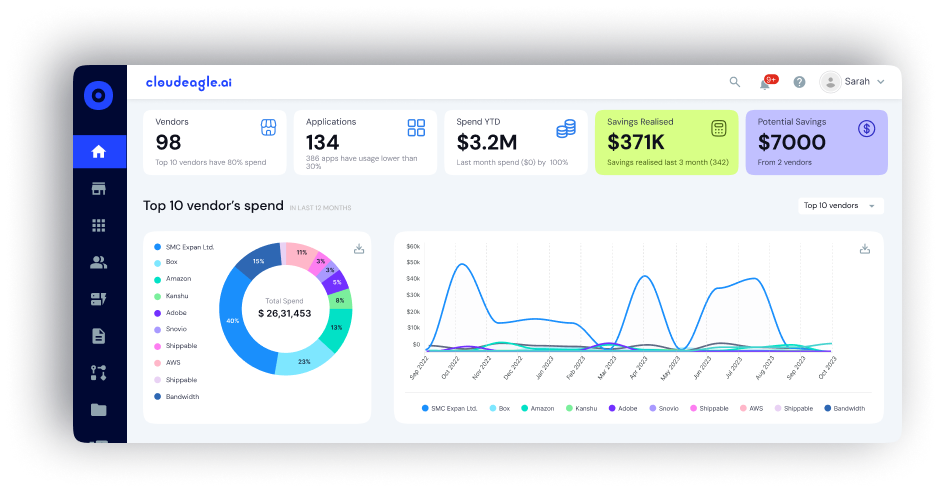
By integrating with 500+ SaaS and AI applications, it automatically uncovers tools that operate outside IT visibility, consolidates usage and spend data, and gives leaders a single source of truth. Within minutes, enterprises gain a holistic view of their SaaS environment, helping them make faster, smarter decisions.
What CloudEagle.ai delivers:
- Discovers every SaaS and AI app across the enterprise.
- Maps users, usage, and costs in real time.
- Uncovers shadow IT and duplicate tools.
- Centralizes SaaS inventory with ownership and renewal details.
- Provides instant insights through unified dashboards.
Check out this success story of how CloudEagle.ai saves RingCentral $250K by consolidating duplicate apps.
2. Streamlined Procurement and Renewal Workflows
Renewal and procurement chaos can drain resources and budgets fast. Many enterprises manage renewals through spreadsheets and email chains, often missing early termination windows and losing leverage during vendor negotiations.
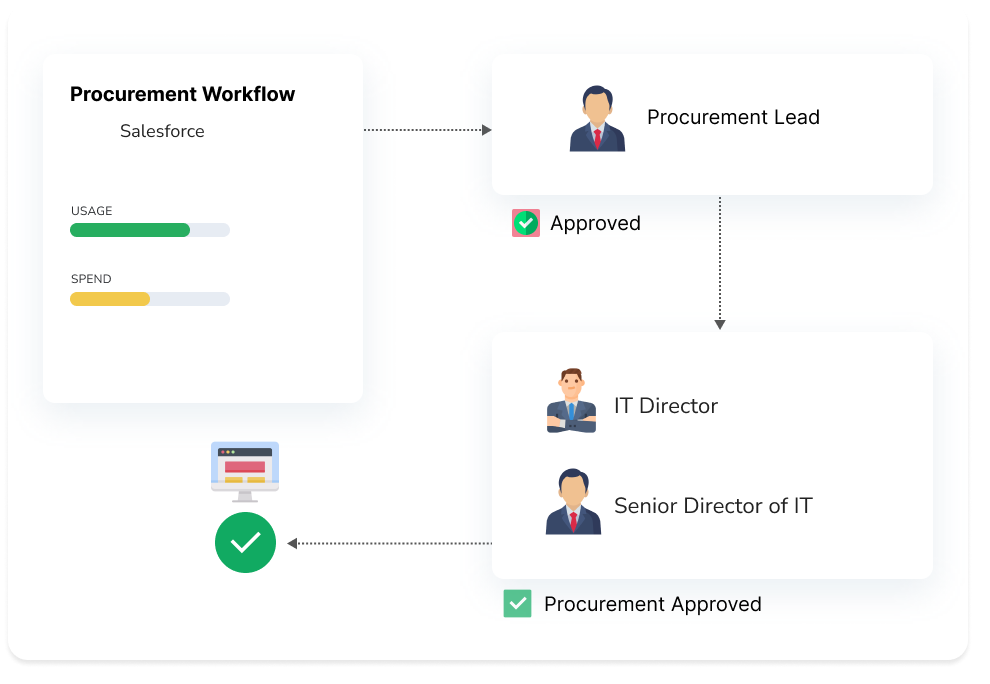
CloudEagle.ai eliminates that pain with automated procurement workflows and AI-powered renewal management. From tracking renewal timelines to extracting contract metadata using AI and benchmarking vendor prices, CloudEagle.ai ensures every purchase and renewal is optimized for savings and compliance.
What CloudEagle.ai delivers:
- Automates renewal tracking and approval workflows.
- Extracts contract data with AI for faster processing.
- Sends smart renewal alerts and negotiation reminders.
- Provides real-time vendor pricing benchmarks.
- Stores all contracts and compliance data in one place.
3. Automated User Lifecycle Management
Manual onboarding and offboarding processes are risky and inefficient. Delayed deprovisioning can leave security gaps, while inconsistent onboarding slows employee productivity.
CloudEagle.ai automates the entire user lifecycle management process, integrating HR, IT, and identity systems (like Okta, Microsoft Entra, and Workday) to ensure access is provisioned and revoked instantly based on employee status.
This not only improves security but also ensures compliance with frameworks like SOC 2, ISO 27001, and GDPR, while saving IT hundreds of hours each year.
What CloudEagle.ai delivers:
- Automates onboarding/offboarding across all SaaS tools.
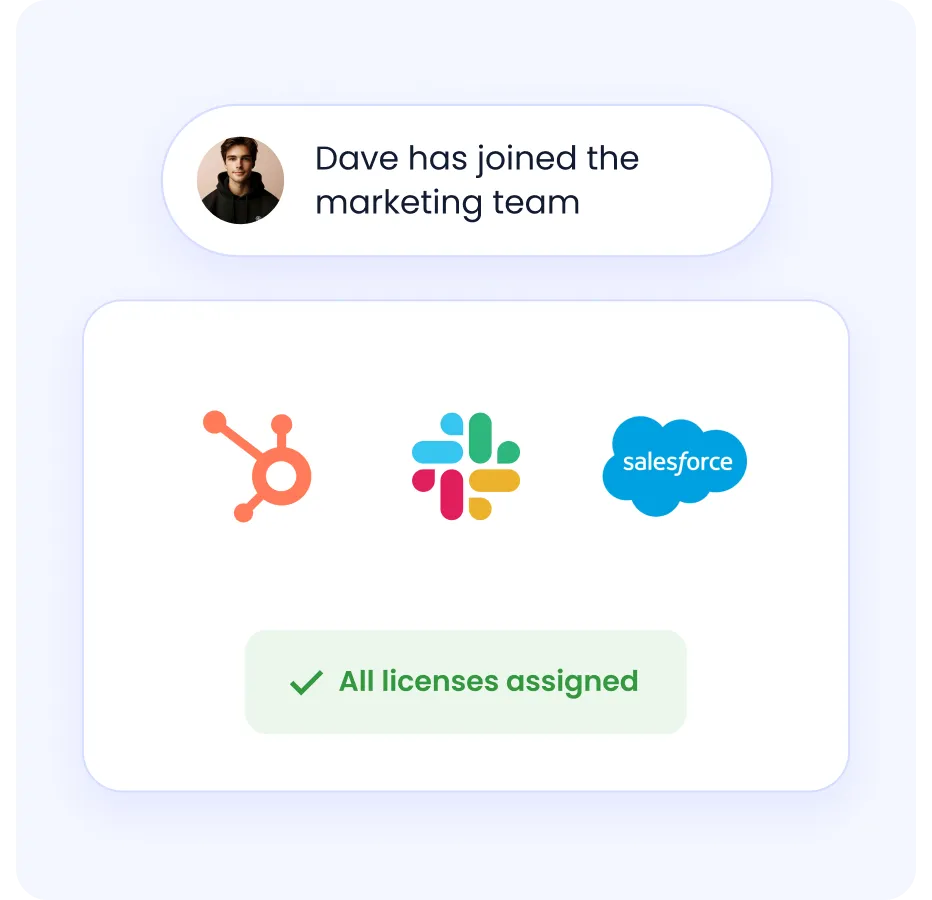
- Syncs with HRIS and IDP systems for real-time access control.
- Maintains audit-ready access logs.
- Reduces insider threat risks through instant access revocation.
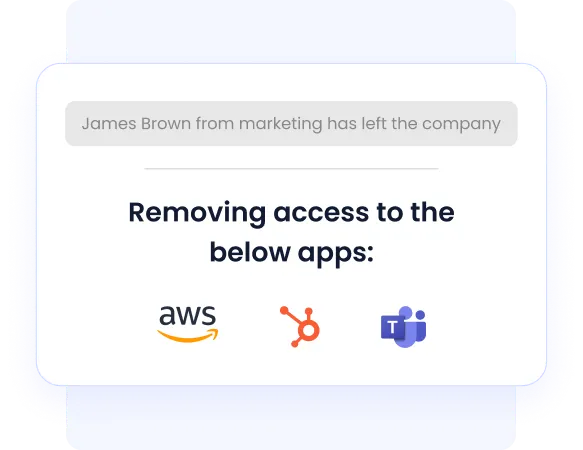
- Ensures compliance through continuous user access governance.
4. AI-Powered Optimization and Cost Savings
SaaS waste is one of the biggest drains on IT budgets, with unused licenses, redundant apps, and overlapping functionalities often going unnoticed. CloudEagle.ai uses AI and advanced analytics to identify underused licenses, duplicate apps, and cost anomalies across your SaaS stack.

It translates this data into actionable recommendations that help the enterprise right-size licenses, consolidate tools, and reallocate spend more effectively. With predictive spend forecasting and vendor performance tracking, CloudEagle.ai turns SaaS management from a cost-control exercise into a strategic financial advantage.
What CloudEagle.ai delivers:
- Tracks license utilization and identifies underused seats.
- Detects duplicate or redundant SaaS tools.
- Provides predictive spend and renewal analysis.
- Suggests cost reallocation and optimization strategies.
- Offers AI-generated vendor performance scorecards.
5. Continuous Monitoring and Compliance Governance
As enterprises scale, maintaining compliance and continuous supervision becomes a top priority. CloudEagle.ai enables real-time SaaS monitoring, ensuring that access, spend, and compliance remain under control at all times. With built-in compliance tracking for SOC 2, ISO 27001, and GDPR, it ensures every department meets enterprise standards without manual intervention.

What CloudEagle.ai delivers:
- Real-time visibility into usage, access, and compliance.
- Automated policy enforcement and access reviews.
- Continuous compliance monitoring for global standards.
- Alerts for unusual activity and shadow IT risks.
- Integrations with security tools like SIEM, CASB, and DLP.
Discover how Dezerv automated its app access review process with CloudEagle.ai.
6. Outsourced Procurement and Price Benchmarking
Negotiating SaaS contracts can be time-intensive and costly. CloudEagle.ai offers an outsourced procurement service, enabling enterprises to outsource renewals and negotiations to experts backed by real-time price benchmarking data.
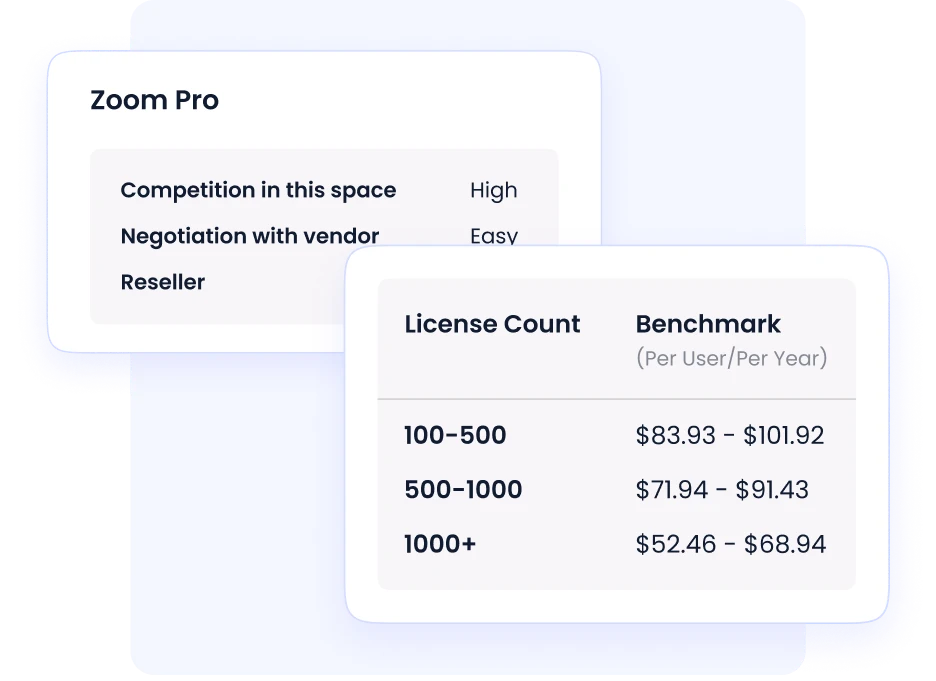
CloudEagle.ai’s procurement experts use industry-standard price benchmarking data and vendor insights to help customers secure better terms, faster renewals, and higher savings, freeing up internal teams to focus on strategic priorities.
What CloudEagle.ai delivers:
- Managed renewals and vendor negotiations handled by experts.
- Access to global SaaS pricing benchmarks.
- Faster, risk-free renewals with minimal effort.
- Expert insights on vendor performance and deal quality.
- Strategic cost savings without the administrative burden.
Know how Nowports secures 34% savings with CloudEagle.ai's effective negotiation.
7. License and Vendor Management
Managing SaaS vendors and licenses can quickly become complex as enterprises scale. CloudEagle.ai simplifies vendor management by consolidating all vendor data, renewal timelines, and license usage into one clean interface.
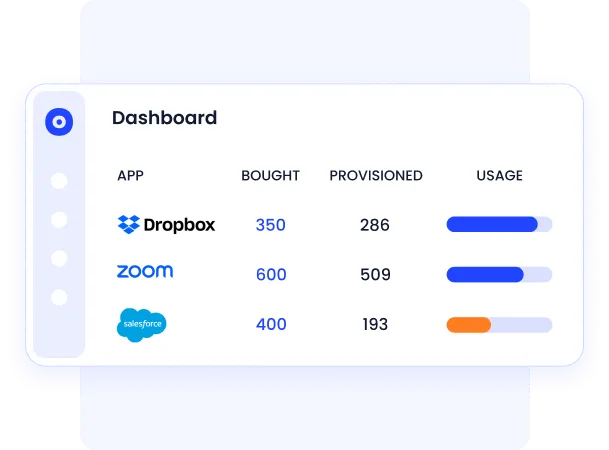
This unified view helps IT and procurement teams align vendor relationships with business priorities, avoid overspending on unused licenses, and make data-backed renewal decisions with confidence.
What CloudEagle.ai delivers:
- Centralizes vendor data and renewal details.
- Tracks license usage and renewal performance.
- Highlights right-sizing opportunities across departments.
- Simplifies vendor communications and renewals.
- Ensures cost transparency for every contract.
Check out this testimonial from Iffi Wallah, Co-founder and CEO of Edge, as he shares how Edge gained complete visibility and control using CloudEagle.ai.
Conclusion
The journey through the SaaS maturity model isn’t about perfection; it’s about progress. As enterprises move across the SaaS maturity levels, they gain greater visibility, control, and efficiency in managing their SaaS ecosystems.
Enterprises that adopt structured SaaS governance frameworks save 20–30% in software spend, reduce compliance risks, and free IT teams from repetitive manual work.
Whether your enterprise is starting at the Ad-Hoc stage or advancing toward strategic automation, every step forward improves your ability to make smarter, data-driven, and secure SaaS decisions.
To achieve this efficiently, it’s essential to adopt an automated SaaS management platform like CloudEagle.ai that simplifies discovery, optimizes costs, and automates governance across your entire SaaS stack.
Are you ready to transform your enterprise’s SaaS management?
Schedule a demo with CloudEagle.ai to automate, optimize, and scale your SaaS ecosystem.
FAQs
1. What are the 5 maturity levels?
Some frameworks extend the SaaS maturity model to five levels: Initial (Ad-Hoc), Managed, Defined, Optimized, and Innovative. These levels show how companies move from manual, unstructured SaaS management to fully automated and data-driven operations.
2. What is the rule of 40 in SaaS?
The Rule of 40 is a simple benchmark for SaaS companies. It means that a healthy SaaS business should have its growth rate + profit margin = 40% or more. This helps leaders strike a balance between rapid growth and profitability.
3. What is the 3 3 2 2 2 rule of SaaS?
The 3-3-2-2-2 rule outlines ideal yearly growth targets for SaaS startups — 300% growth in the first two years and 200% growth in the next three. It’s used as a guide for sustainable and realistic scaling.
4. What is the Gartner 5 stage maturity model?
Gartner’s 5-Stage Maturity Model describes how organizations grow in managing technology and processes: Initial, Developing, Defined, Managed, and Optimizing. For SaaS, it mirrors the SaaS maturity levels, measuring progress in automation, governance, and data-driven decision-making.
5. What is the software maturity framework?
A software maturity framework enables enterprises to assess their ability to manage, maintain, and continually improve their software systems. The SaaS maturity model is a part of this framework, focused specifically on cloud-based apps, cost control, and governance maturity.

%201.svg)








.avif)




.avif)
.avif)




.png)
